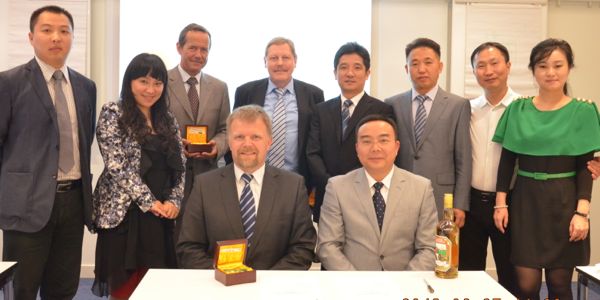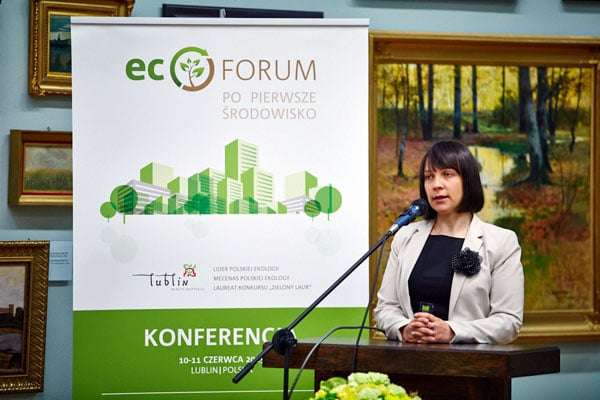At several recent high-level gatherings, Green Business Norway had the opportunity to share experiences and talk strategy with Polish decision makers.
Poland’s future options for waste management were a recurring theme at the meetings. Green Business Norway outlined best-practice solutions from several of its member businesses.
New household waste management system
The topic at this year’s European Congress of Local Governments was “Poland’s waste management reforms – a step forward or a step back?” Green Business Norway delivered a presentation on optimal solutions for household waste.
Anna Larsson, Green Business Norway’s market director in Poland, noted that the country had made progress on waste management methods, but still needed to increase efficiency and reduce the amount of waste going to landfill. “Only a small proportion of the waste collected actually gets recycled, and Poland still has some way to go when it comes to domestic food waste,” said Ms Larsson, who also attended the assembly of the Polish National Forum of Waste Management Directors and gave a presentation at the Gdansk University of Technology this spring.
Nationwide source-separation system planned
Green Business Norway was invited to provide input on the Polish government’s plans to launch a nationwide system for separating household waste at source. Ms Larsson commented that the extent of waste separation depends on local conditions and on existing market solutions. It is outmost important that citizens source separate food waste which secures better outcome from biogas-fertilizer production. The rest of daily wastes does not need pre-sorting and can be separated centrally. As an example of best practice, she cited Romerike Avfallsforedling (ROAF), which has built Europe’s most modern waste separation plant at Skedsmo.
“ROAF’s central sorting plant separates out pre-sorted food waste in green bags and recyclables, including five different plastic waste streams: PET, PP, PE, foil and mixed plastics. This approach has proved simpler and more effective than requiring households to sort their waste more thoroughly.
“An increasing number of municipalities in Scandinavia are choosing this method,” said Ms Larsson, adding that central sorting based on pre-sorted waste streams (food waste and residual) has become a visible trend. She also pointed out that Scandinavia achieves high recycling rates for beverage containers thanks to the centralized deposit program – a cost-effective system with a collection rate of over 90 per cent.

Members of this year’s panel at the European Congress of Local Governments included Yurii Chyzhmar, a member of the Ukrainian parliament, and Marek Wojtkowski, the mayor of Wloclawek in Poland. The moderator was Maciej Kie?bus from the journal Community.
Energy from waste and biogas production
At the assembly of the Polish National Forum of Waste Management Directors, there was great interest in the best available technology for energy recovery from waste, and in Scandinavian experience in this field.
Green Business Norway noted that energy can be recovered from residual waste in energy-from-waste plants and by using food waste to produce biogas.
“The Scandinavian experience shows that careful planning of household waste incineration capacity is essential. Norway and Sweden are currently facing challenges resulting from excess capacity,” said Ms Larsson, who also stressed the importance of putting in place the framework for a circular economy.
“Small-scale energy-from-waste plants designed to process residual waste locally would be the optimum solution,” she added.
Greater awareness of energy from waste
In the countries of eastern Europe, too, there is an increasing focus on energy from waste. However, citizens and decision makers in these countries have yet to recognize the benefits of biogas production from the food waste stream.
“Producing biogas from food waste allows us to recover both energy and valuable nutrients. In Scandinavia, biogas plants are gaining traction as the most sustainable form of food waste treatment,” reported Ms Larsson.
In this connection, she pointed to two Norwegian success stories. The CAMBI biogas plant in Oslo is central to the city’s emissions reduction strategy. The GLØR biogas plant in Lillehammer is part of a regional drive for sustainable waste management.
CAMBI’s joint ventures with sludge treatment and waste management businesses at Verdal in Norway and Växjö in Sweden were also mentioned as examples of co-digestion facilities. These plants accept two types of substrate – municipal food waste and sewage sludge – which are handled simultaneously in a single process.
CAMBI’s thermal hydrolysis process, used in all its plants prior to digestion, offers significant benefits in terms of biogas yield, process optimization, hygiene and digestate quality.
Speaking after the event, Wojeciech Janka, president of the Forum, said:
“The Forum supports solutions and technologies designed for simple and efficient sorting of recyclables. We are also in favour of energy recovery from residual and food waste. The best available technology from Scandinavia offers maximum recovery rates both for valuable recyclables and for energy from pre-sorted food waste in the form of biogas.”

Anna Larsson, Green Business Norway’s deputy CEO and market director in Polan at the European Congress of Local Governments.
Leading research centre on biogas from food waste
The Gdansk University of Technology aims to be Poland’s leading centre for research into producing biogas from food waste. Green Business Norway was invited to give a presentation on Scandinavian experiences regarding food waste collection methods and biogas production and use.
The research team, led by Professor Jan Hupka, is in the process of completing a bilateral Polish-Norwegian project studying organic waste in the Pomorskie region. The team is now considering extending its collaboration with Green Business Norway on biogas from food waste.

Anna Larsson, Green Business Norway’s deputy CEO and market director in Polan visiting The Gdansk University of Technology.
























































































